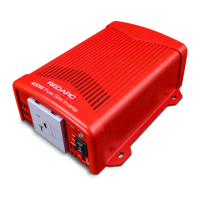21
3 INSTALLATION
NOTICE
Install the inverter in a well-ventilated area with reasonable clearance. Do not install the inverter in a
zero-clearance compartment or obstruct the ventilation openings. Doing so may result in the inverter
overheating and ultimately damage the inverter.
3.3 Safety Before Installing DC Wiring Connections
3.3.1 Loads Are Disconnected
Make sure all loads are disconnected from the inverter's AC output and ensure that the inverter main
switch is set to the OFF position before connecting DC cables.
FIGURE 3.3.1: Ensuring loads are disconnected FIGURE 3.3.2: Switch is set to OFF position
WARNING
RISK OF ELECTRICAL SHOCK. BEFORE PROCEEDING, CAREFULLY CHECK THAT THE INVERTER IS NOT CONNECTED TO
ANY BATTERIES AND THAT ALL WIRING IS DISCONNECTED FROM ANY ELECTRICAL SOURCES. DO NOT CONNECT THE
OUTPUT TERMINALS OF THE INVERTER TO AN INCOMING AC SOURCE.
3.3.2 Check Cable and Fuse size
Make sure to use suitably rated cables and fuses for your installation, refer to Section 2.2.4 (page 19)
for more information.
NOTICE
Use suitably rated cable as per section 2.2.4 (page 10). A cable below the recommended rated length
will result in an increased voltage drop when the inverter is under load, which will ultimately effect the
inverters performance.
Do not operate inverter with damaged or underrated cables or without an appropriately sized fuse. Under
sized cables and/or an over-sized fuse may result in harm or damage to the installer and/or damage to
the inverter or other appliances installed in the system.

